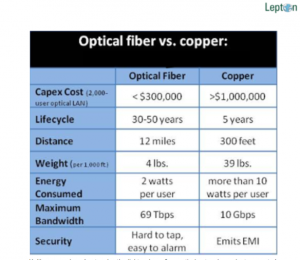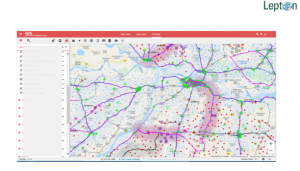Optical fiber networks are revolutionizing the way we communicate and transmit data, offering unparalleled speed and reliability. Built with optical fiber technology, these networks use light pulses to transfer data over long distances, making them one of the fastest and most efficient means of data transmission. As the demand for faster and more reliable internet connectivity grows, optical fiber networks play a crucial role in meeting the increasing needs of businesses and consumers alike. This guide explores the many benefits of optical fiber networks, the different types available, and the future of fiber technology as it continues to evolve.
Why Optical Fiber Network?
An optical network is a type of data communication network built with optical fiber technology. It uses optical fiber cables to transmit data as light pulses between the sender and receiver.

Optical network is one of the fastest communication networks. An optical transmitter turns electrical signals into light pulses, which travel through a fiber optic cable to a receiver.
Optical networks carry light pulses much farther than copper networks before needing a repeater to refresh the signal. When the signal arrives at its destination, an optical receiver changes it back into an electrical signal and forwards it to the recipient node.
Optical networks are less affected by interference and signal loss, offering much higher bandwidth speeds compared to copper networks.
Future of Fiber
Ubiquitous, high speed and low latency networks will require deep fiberization and high growth in network density. The number of network end points will surge due to increasing FTTx penetration, 5G (10-20x small cells per macro cells) and IoT (up to 10 devices per person). All this will require significant network creation with deep fiber deployment and high increased density.
The demand for fiber is expected to grow rapidly with the expansion of faster 4G/5G networks and the widespread adoption of technologies like IoT, augmented reality, virtual reality, and cloud computing, driving significant growth in the optical fiber cable (OFC) industry.
Benefits of Optical Fiber Networks
Below are the top benefits of Optical Fiber Networks
Unparalleled Speed – Optical fiber networks provide extremely fast data transmission, ensuring minimal delays and higher productivity for businesses and users.
Exceptional Bandwidth: These networks can process large amounts of data, making them perfect for data-heavy applications like video streaming, gaming, and cloud computing.
Enhanced Reliability: Resistant to environmental factors like weather and radiation waves interference, optical fibers ensure consistent performance.
Secure Communication: Optical fibers are difficult to tap, providing a secure medium for transmitting sensitive information.
Cost Efficiency Over Time: While the initial investment may be high, optical fiber networks are more durable and need less maintenance than traditional copper cables, leading to lower costs in the long run.
Eco-Friendly Solution: With lower power consumption and reduced carbon footprint, optical fiber networks contribute to sustainable technology infrastructure.
What is Fiber Planning & Why need of efficient planning
Fiber optic network design refers to the specialized processes leading to a successful installation and operation of a fiber optic network. It includes first determining the type of communication system(s) which will be carried over the network, the geographic layout (premises, campus, outside plant (OSP, etc.), the transmission equipment required and the fiber network over which it will operate. Designing a fiber optic network often involves connecting to other networks that may use copper cabling or wireless technology.

Next to consider are requirements for permits, easements, permissions and inspections. Once we get to that stage, we can consider actual component selection, placement, installation practices, testing, troubleshooting and network equipment installation and startup. Finally, we have to consider documentation, maintenance and planning for restoration in event of a future outage.
According to the International Telecommunication Union (ITU), optical fiber networks power over 95% of the world’s internet traffic, making them essential for global connectivity
The design of the network must precede not only the installation itself, but it must be completed to estimate the cost of the project and, for the contractor, bid on the job. Design not only affects the technical aspects of the installation, but the business aspects also.
Even before the network has been built, decisions are made that will determine important aspects of its future operations and maintenance. Therefore, the best basis for the efficient operation and maintenance is a well-considered and consistent network strategy from the outset. The strategy should cover all aspects of how the network will be built and extended, including the network topology and architecture, the design rules and the choice of equipment. During the strategic planning phase, the network operator decides how the network will be built. There is much more to consider than just the initial investment.
Telecom Inventory Management Get Details
Although it is important to reduce the capex because of its impact on the feasibility of the business case, the opex should also be carefully considered. For every deployment option the operator should evaluate how this would affect the cost of future operation and maintenance processes, such as customer provisioning, network maintenance and repair, and how easily the network could be extended and upgraded. Please note that this paper focuses on the technical aspects of the deployment strategy only. The dependencies of the ownership and financial models, which also influence strategic decisions, are beyond the scope of the paper and will not be taken into account.
Scope of Lepton GIS in Optical fiber network planning, inventory management & analysis-
Outside plant installations depend heavily on maps and data about the cable plant route. This can include basic data on the local geology, locations of road, buildings, underground and aerial utilities, and much more. For example the type of ground along the route can determine the methods of underground installation, with deep soil permitting direct burial, other soils requiring trenching and conduit and rocky areas precluding underground installation of any type. Aerial installations must be based on knowledge of the owners of the poles and the processes necessary to gain permission to use the poles and make ready for new cable installations.
Also Read: How geospatial intelligence revolutionizes fiber network deployment
Lepton’s Network Access (NA) & SmartInventory (SI) are GIS analysis & Inventory Management platform created with very detailed & high precision Google maps. Moreover it can be customized as per user requirements of planning and or analysis. It is web based & can be accessible over internet. It does not depend on the system hardware neither has any requirement of additional software installation.
NetworkAccess for Planning
Network Access tool has Geographical data, building data, roads, crossings, railways, landmarks, Soil type data, locality & population data available with PIN codes, Tehasils, villages, cities, districts & State boundaries. That is used for the Desktop Planning of Fiber Network that will reduce the Time, Cost, Manpower requirement for field Surveys. Centralised planning team can monitor field surveys with the help of Lepton’s Workforce Management (WFM) mobile based application tool Smart Operations. This will help finalising Fiber Network planning with pinpoint accuracy.
While planning we have to consider the existing Fiber network of same operator or other operators, other underground cables, pipelines, power lines etc. With the help of Network Access it is very convenient to plan considering every other considerable aspect.
SmartInventory for management
A bigger challenge for telecos is managing its on field inventory. Even though if it is available to some it’s not accessible or available to all. It’s also has the problem when multiple stake holders carry & manage multiple entities of a single network. Lepton’s Smart Inventory tool specially designed to overcome similar & many other problems.
It has every network component & its inventory available over the GIS platform. As built fiber layouts, chambers, manholes, Joint-closures, documents like requests, permissions, legal authority letters, ROW letters, Site-data like Tower locations, shelters, racks, equipment, cards, antennas & connectivity details. Microwave details, backhaul details, POP locations & every minute details available on Geo-based platform. It can be made accessible to every stake holder in the organization who will be responsible for maintaining and managing this. That helps to do the analysis, understand, manage, maintain and update any changes in the network in easier way.


With the help of Network Access & Smart Inventory together with Smart Fiber it is very convenient to analyse, manage and update every detail of the network.
Analysis tools for every network is available over Network Access platform. Analysis like Feasibility, Grid, buffer, distance, covered population, network KPI, Fiber-cut etc. can be performed easily and faster.
After analysis every change in inventory can be maintained. That will keep track of every update of network, its faults, its implemented solutions and problems faced.
This blog is limited with length. So we could not cover each and every functions and applications of NetworkAccess, & SmartInventory.
Ready to optimize your network with cutting-edge solutions? Contact Lepton Software today for a free consultation and discover how our telecom solutions can transform your connectivity. Request a Demo

